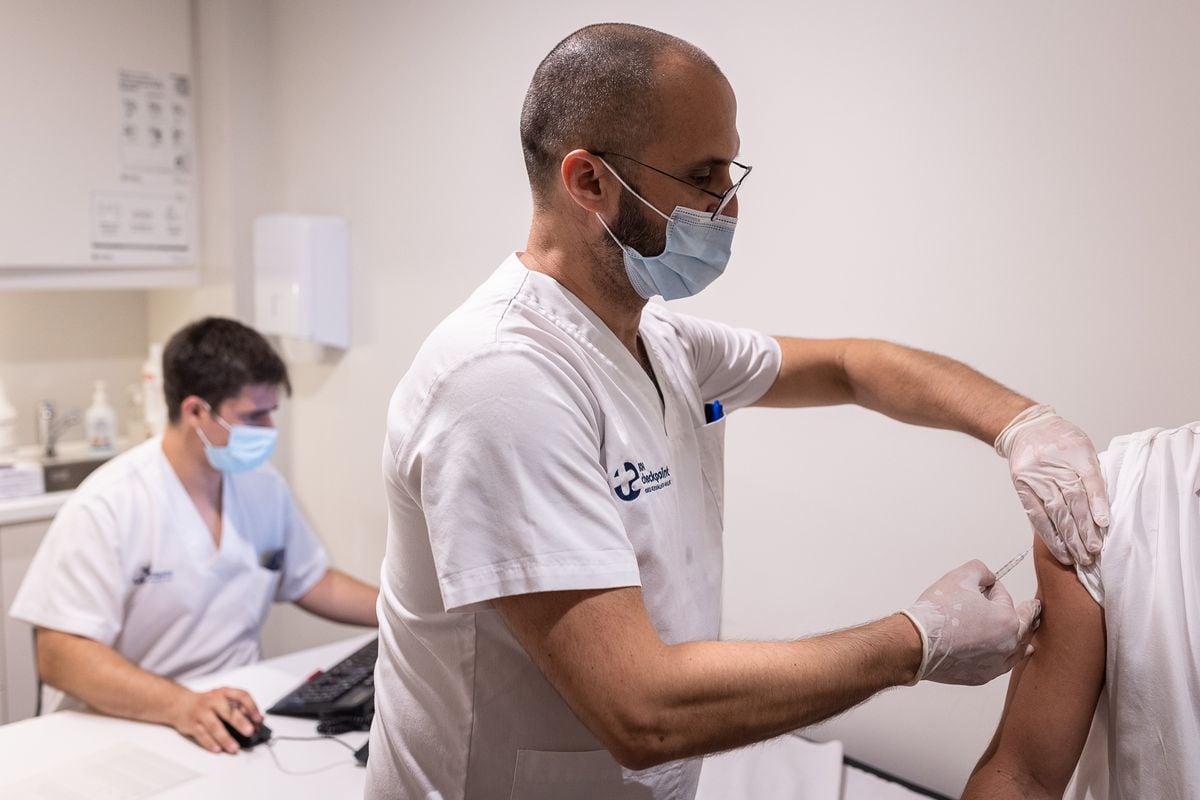With Spain as the most affected country, with nearly 3,400 confirmed cases, the outbreak of monkeypox in development for more than two months continues to spread throughout the world.
There are already more than 16,000 registered infections in almost 80 countries and territories, data that has led the World Health Organization (WHO) to convene this Thursday the second meeting of experts to evaluate again whether the current situation constitutes "a public health emergency of international concern”.
This is the highest level of alert collected by the International Health Regulations.
At the first meeting, held on June 23, the WHO experts considered that it was too soon to take this step, which would mean giving smallpox a consideration that currently only coronavirus and polio have.
The three reasons that led them to adopt this decision were the lightness of the vast majority of diagnoses, the low transmission of the virus outside groups with risky practices —men who have sex with men in environments where close contact with men is frequent multiple partners and strangers—and the sustained but not exponential growth of cases.
In the four weeks that have elapsed, cases have quadrupled in the world, going from 4,000 to 16,000, and the number of affected countries has practically doubled, to almost 80. If this growth justifies a change in the position of the WHO, whose decision will be will know in the next few days, is something that is now being debated by the experts convened by the body.
The statement published after the first meeting established eight sensitive points to which special attention was to be paid to assess the evolution of the outbreak.
If “one or more of them” occurred, the text pointed out, the declaration of an international emergency would be justified.
The meeting takes place in the same week that Spain has started the vaccination of those people who request it and meet the requirements (men who have maintained risky practices or may be exposed to the virus), although the campaign is slowed down by the low number of doses available.
Spain has so far agreed to 5,000 units and expects to receive more in the coming months within the joint purchase of the European Union (160,000 doses so far).
The opinion of the experts consulted is that, despite the increase in infections, the conditions to declare an international emergency do not exist for the same reasons that the first WHO meeting did not.
"The cases continue to rise and the measures adopted to track infections and immunization have not had an effect, but I do not think that the points established by the WHO to take the step are met," says Carlos Maluquer de Motes, professor of molecular virology at the University of Surrey (UK) and an expert on smallpox.
“The current outbreak is a very important public health problem that deserves close monitoring and the development of measures.
But this strategy that the countries must follow would change little with an international declaration, nor does it seem that a qualitative leap like the one given in the covid at the international level is necessary, ”defends Daniel López Acuña, former director of WHO Health Action in Crisis.
The following are the eight points analyzed by the WHO experts:
1. Evidence of an increase in the growth rate of cases in the currently affected groups or in others.
When the first meeting was held, some 223 positives per day were being reported worldwide, according to information provided by governments and compiled by EL PAÍS.
Currently, they are 647 and the trend is upward.
In relative terms, however, growth tends to slow down and cases have gone from doubling every 8 or 10 days to every 14. These data, in any case, are affected by notification delays, since while some governments report daily about the new positives, others barely do it once a week.
The vast majority of infections, more than 90%, continue to occur with so-called risky practices.
But as the number of infections grows, the profile of those affected also expands.
According to the latest balance of the epidemiological situation published by the Carlos III Health Institute, dated July 19 with data from 2,622 patients, 25 of them were women and 11 were under 20 years of age.
Of the 1,317 positives for whom there was information on the possible source of exposure to the virus, "77 cases reported exposure during leisure activities (non-sexual) and 18 exposure in the family environment", that is, 7.2% of the infections had occurred in other environments.
“There is a sustained growth in cases that is expected to continue for a while longer, but the total magnitude is limited.
There are other diseases that have a greater magnitude and a higher risk of contagion that have not merited the declaration of an international emergency,” says Daniel López Acuña.
2. Diagnosis of cases among “sex workers”.
Although there is little information available on this point, the studies published by the different European countries include in some cases patients who declare that they belong to this group.
"It would not be surprising if there were cases given the risk groups and the mechanism of transmission of the virus, although they do not seem to have a significant weight in the total number of cases and infections," defends Daniel López Acuña.
3. Significant spread of the virus in new countries, as well as significant increases in endemic ones.
Every day that passes, some country is added to the list of those already affected by the outbreak and there are already almost 80. Most of them, however, register the cases mainly in people from the most affected areas.
The countries in which circulation is community-based and diagnoses are growing strongly are a minority.
The United States and Brazil are the two where they are growing the fastest in relative terms.
The first is already the second most affected in the world, with nearly 2,500 positives this Thursday, twice as many as a week ago.
Brazil has reported 598, nearly triple the number seven days ago.
Among the most affected European countries, Spain is the one that is growing the fastest (about 100 cases per day), while in Germany and the United Kingdom about 70 are being identified per day.
In the endemic countries of West Africa - the variant of the monkeypox virus causing the outbreak comes from this area, which is less lethal than the one that circulates in central Africa - there is also a slight increase in diagnoses, although very far from it. of the European and American figures.
4. Increase in the number of diagnoses in vulnerable groups such as immunosuppressed people, including HIV cases without adequate treatment, pregnant women and children.
The Community of Madrid reported this Thursday the case of a seven-month-old baby, in what would be the contagion to a younger person than those registered in Spain.
His clinical evolution is favorable at the moment.
Infections in children, pregnant women and immunosuppressed people are the most worrying, because the scientific literature collected in endemic countries shows that they are the ones with the highest risk of suffering serious or fatal clinical conditions (for the fetus in the case of pregnant women). ).
Although there has been an increase in cases in minors and there have already been at least thirty (not all countries report the age of the patients), for now these groups do not represent a significant percentage of the total number of cases and No deaths have been recorded.
5. Increased severity of cases.
Experts rule out that this has occurred.
“The patients we have treated have cases that are easy to resolve and have not required special treatment or care, even with more localized and less extensive eruptions than those reported in the literature.
The biggest problem has been the intense pain and discomfort caused by the rash in the perianal areas,” explains Santiago Moreno, head of infectious diseases at the Ramón y Cajal Hospital.
A total of 52 people have been hospitalized in Spain between May 5 and July 16 for monkeypox, 3.9% of the 1,317 cases studied by the Carlos III Institute.
This percentage rises to 8% in other European countries, although in almost all cases admission is to relieve pain.
6. Evidence that the virus is transmitted and circulates between animal species.
In the endemic countries of Africa, the virus reservoir is small mammals from which it jumps to other larger species and to humans.
The biggest fear is that this will also happen in countries hitherto free of the virus, which would make it virtually impossible to prevent it from becoming endemic.
So far there is no evidence that this has occurred.
7. Changes in the virus genome associated with greater transmissibility, virulence, escape from the immune response or resistance to antivirals.
Genetic studies carried out to date show that the currently circulating virus accumulates fifty mutations compared to the one sequenced in 2018 in the United Kingdom, when the country suffered a small outbreak from a case imported from Nigeria.
Some researchers point out that this amount is high for a DNA virus, much larger and more stable than RNAs, such as the coronavirus.
However, no work has concluded that these changes give the virus greater contagiousness or virulence.
If it is transmitted more now, it seems that it is due to the fact that it has entered a niche in which it is much easier for it to circulate than due to the mutations it has undergone.
8. Outbreaks caused by more virulent virus variants detected in new countries outside of Central and West Africa.
So far there is no news of outbreaks of these characteristics.




/cloudfront-eu-central-1.images.arcpublishing.com/prisa/NS3ZU25XBNH4BJLTJPBCRCLEXE.jpg)




